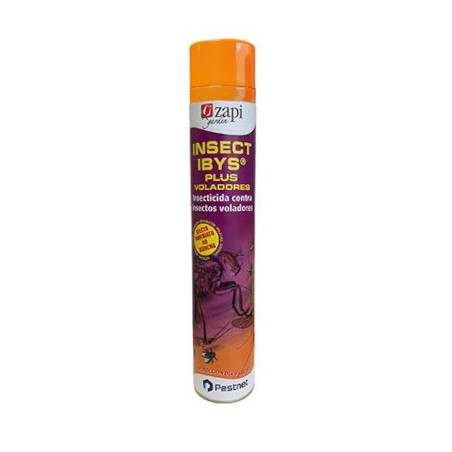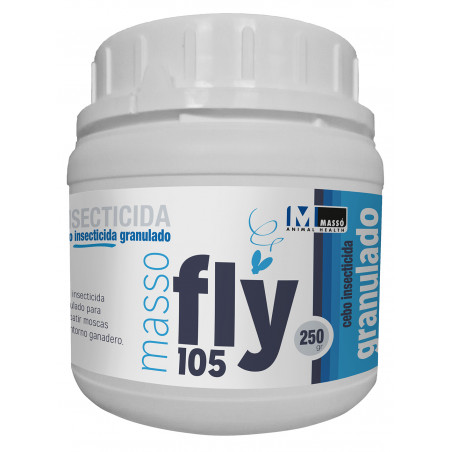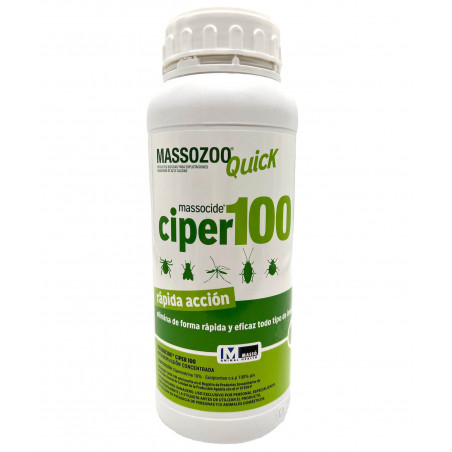Since the first of February 2005 the Product Boards for Livestock, Meat and Eggs (PVE) have made Salmonella monitoring of fattening swine obligatory for all herds that produce fattening swine in the Netherlands. Sow herds that do not produce fattening swine, are not part of this monitor.
Every four months, 12 blood samples should be taken and tested for antibodies against Salmonella. Samples can be collected in two ways. Firstly, they can be taken by the local veterinarian during herd visits, or secondly, they can be collected at the abattoir. If samples are collected at the farm, the sampled fattening swine should be close to slaughter weight and no more than 3 weeks before slaughter. At the abattoir, blood samples are collected immediately after sticking. Samples are tested at the lab using the Salmonella mix-Elisa for swine from IDEXX. As a result OD-percentages are communicated to the herd owner.

Based on these OD-percentages from 36 samples collected over the last year, herds are categorized into 3 categories: low (I), medium (II) or high (III) risk. The cut-off to distinguish positive samples is OD%>40, the same as in Germany. However, the calculation of the category is slightly different than in Germany. First, a score is calculated per 12 samples / 4 months (table 1).
Table 1. Salmonella scoring system.
| Cut-off per group | Score |
| <20% positive samples (1 or 2 positives) | 1 |
| >20% but <40% (3 or 4 positives) | 2 |
| >40% (5 or more) | 3 |
Next, the 3 scores of the last 3 periods of 4 months are added up to a final score (table 2).
Table 2. Salmonella categories.
| Sum of scores | Salmonella category |
| 3 or 4 | I |
| 5, 6 or 7 | II |
| 8 or 9 | III |
On average 75% of the herds are in category I, 20% in II en 5% in III.
However, since the end of the Product Boards in 2013, this obligatory rule has been transferred to the 2 existing quality assurance schemes which are operational in The Netherlands. About 95% of all pig farms produce pigs within one to these QA-schemes. These QA-organisations do not publish results on the Salmonella monitoring. So, current information on the Salmonella status of Dutch pig farms is not available. Personal experience leads me to belief that the Salmonella-status in The Netherlands has not changed dramatically over the years and information gained from QS in Germany confirms this.
Implications for herds in category II and/or III
Within this monitoring scheme, there are no obligatory improvement measures for herds in category II or III. Pressure to improve the Salmonella-status comes from German slaughterhouses, because quite a number of Dutch fattening pigs are being slaughtered in Germany. Some German slaughterhouses put a financial penalty on pigs from status III herds, some as much as € 0.03 per kilogram of slaughter weight. In case an improvement plan has been submitted, this can be reduced to € 0.015 per kilogram, but at a carcass weight of 95 kilograms, this is still more than € 1.40 per pig. This pressure on the fattening herds translates into pressure on piglet producing herds, because piglets are the main source of introduction of Salmonella for a fattening herd. In turn, the piglet producing herds put pressure on the gilt producing herds, so now, there is an increasing pressure on multiplication herds to produce gilts that are not carriers of Salmonella and on piglet producing herds to produce piglets that are not carriers of Salmonella.
Salmonella risk factors in The Netherlands
In most fattening herds, the biggest risk for the finisher pigs to become infected with Salmonella is the within-farm contamination cycle of Salmonella. This cycle is maintained through insufficient all-in/all-out batch management, inadequate cleaning and disinfection between batches of fattening pigs (Figure 1) as well as insufficient internal biosecurity measures to prevent people from carrying the contamination from compartment to compartment and insufficient pest control, e.g. mice and flies. A general risk factor for Salmonella in The Netherlands is the use of pelleted feed, which is most common. On the other hand, about 25% of the fattening herds use a system of feeding fermented liquid feed (FLF) made of by-products from the human food industry, which offers a strong protection against Salmonella-infection, because this kind of feed has a low pH of about 4.2 and contains lots of Lactobacilli. Most FLF feeding herds have a very good to even negative Salmonella-status. To my knowledge there is no official definition or certificate of a negative Salmonella-status, but the fact is that these herds can have consistent Salmonella monitoring results with OD%-values below 10, the scientific cut-off of the ELISA, for extended periods of time, up to two years. To my knowledge, occasional Salmonella introductions into such herds, which will without a doubt occur, do not result in a spread of the infection within these herds, but will disappear after a while because of this feeding system.
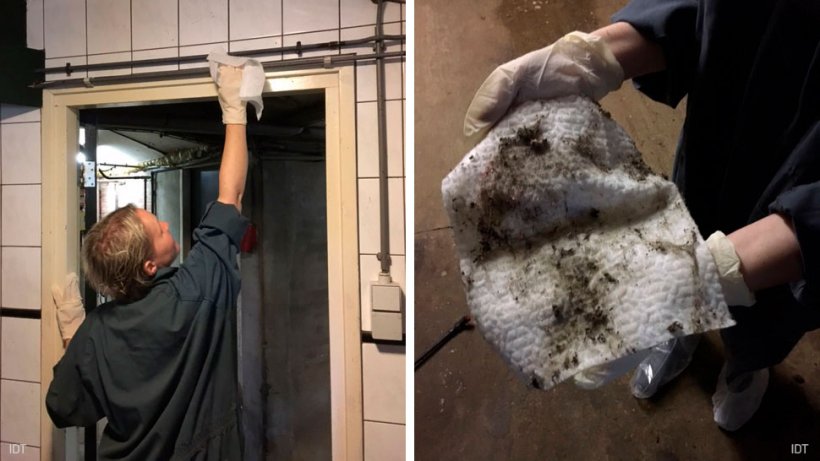
The biggest risk for introduction of Salmonella is buying infected piglets. Results from the EFSA baseline study (2009) show that more than half of the sow herds in The Netherlands were contaminated with Salmonella at any given moment. Incidental serological data from sows indicate that even a larger part of the sow herds is contaminated. Such herds are at risk of producing infected piglets. Whether or not a particular batch of piglets is really infected with Salmonella will depend on a lot of different factors. Mostly, only a minority of all batches of piglets will have piglets in them which shed Salmonella. Therefore, if a fattening herd owner wants to know if the piglets that enter the herd are contaminated, repeated sampling of both fecal samples (Figure 2) and blood samples will be necessary.
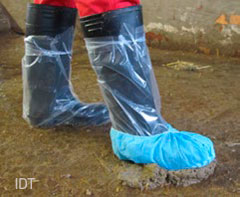
Figure 2. Sock sampling.

At the moment there are no plans, to my knowledge, in The Netherlands to extend the monitoring program into a surveillance program for fattening pigs (so with an obligatory intervention if pigs herds are in a higher status) or introduce a monitoring program for piglet or gilt producing herds.






